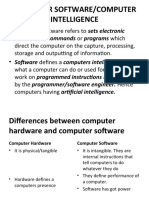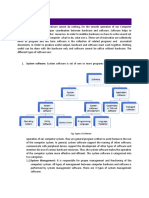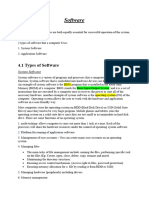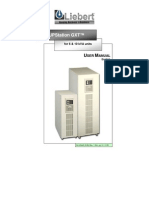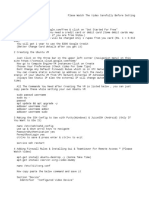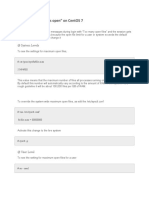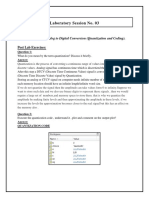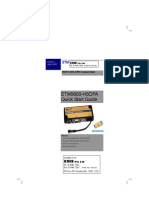Fredrick Muthengi
3.0 Computer Software
3.1 What is Software?
Computer software or simply Software1 refers to a set of instructions that tell a computer
what to do and how to do it. Your computer hardware without the software component is
just a useless metal. This definition implies that computer software is the most important
part of a computer. Also, users have access to the computer resources through the
computer software. Currently, the cost of buying computer hardware is increasingly going
down. The cost of software on the other hand exceeds the cost of hardware. Software is
what makes a computer relevant.
We have two major categories of computer software: (1) application software and (2)
system software. Application software refers to software enables you to solve specific
problems or perform specific tasks. Microsoft PowerPoint, for example, can help you create
slides for a presentation; hence it’s application software. Name other types of application
software: payroll software, inventory management software …
System software refers to software that controls and supports the operations of a computer
system as it performs various information processing tasks. Examples of system software
include: operating system, and utility software.
Application Software
System Software
Hardware
Other categories of computer software include:
Middleware, programming languages, programming tools, firmware, device drivers,
productivity software, multimedia software, entertainment software, educational and
reference software, among others
Firmware – is like prewritten program that is permanently stored in Read-Only Memory
(ROM). The BIOS (Basic Input Output System) instructions are an example of firmware.
1 Software is a set of instructions executed by the computer’s processor to perform a task.
~1~
� Fredrick Muthengi
3.2 Application Software
Application software consists of those programs that solve specific problems for the users
and execute under control of the operating system. The application programs are developed
by individuals and organizations for solving specific problems. In general, application
software is a set of instructions that perform specific tasks. They include:
- specific/customized application software such as payroll software, inventory
management software among others
- Generalized application software that can perform many different tasks. Examples:
word processors, spreadsheets (Excel), presentation software (PowerPoint) etc.
- Other categories of application software: productivity software, entertainment
software, educational and reference software
Productivity software:
Productivity software includes programs that enable you to perform various tasks required
at home, school, and in business. This category includes word processing, spreadsheet,
presentation, database, and personal information manager programs.
~2~
� Fredrick Muthengi
Common features in productivity software:
- Wizard which is a systematic guide that walks you through the steps necessary to
complete a complicated task. At each step, the wizard asks you questions. Based on
your responses, the wizard helps you complete that portion of the task.
- Template which is a predesigned form. Templates provide the basic structure for a
particular kind of document, spreadsheet, or presentation. They can include specific
page layout designs, formatting and styles relevant to that particular document, and
automated tasks (macros).
- Macro which is a small program that groups a series of commands so they will run as
a single command. Macros are best used to automate a routine task or a complex
series of commands that must be run frequently. For example, a teacher may write a
macro to sort the grades in her grade book automatically in descending order and to
highlight those grades that add up to less than a C average. Every time she adds the
results of an assignment or test, she can set up the macro to run through that series
of steps automatically.
Integrated software applications versus software suites
• Integrated software is a single application that incorporates the most commonly
used tools of many productivity software programs into a single integrated stand-
alone program. They don’t include many of the more complex features of the stand-
alone productivity software applications and cost less than individual programs.
- Microsoft Works is an example of an integrated software application that
includes word processing, spreadsheet, and database functionality.
Integrated software applications are perfect if you do not need the more advanced
features found in the individual full versions of each program. An integrated
software program is also less expensive than its individual, fully featured
alternatives.
• A software suite is a group of software programs bundled together as a package.
Because the programs come from the same developer, they work well together and
share common features such as menus and toolbars. They also integrate well.
- Microsoft Office is one example of the many types of software suites on the
market today. You can also buy different versions of the same suite, the
difference among them being the combination of software applications
included in each version. Other Examples OpenOffice among others.
Other developers of software suites: Corel and Lotus
Freeware and Shareware
Freeware is any copyrighted software that you can use for free. Plenty of freeware exists in
the Web, ranging from games and screensavers business, educational, graphics, etc.
Examples: Adobe reader software for reading PDF documents.
~3~
� Fredrick Muthengi
Shareware software is distributed free, but with certain conditions. One way is to release
software free of charge but only for a limited time after which the software expires if not
purchased within the set timeframe.
3.3 Categories of System Software
System software refers to software that controls and supports the operations of a computer
system as it performs various information processing tasks. Examples of system software
include: operating system, and utility software. System software therefore handles tasks
specific to technology management and coordinates interaction of technology devices.
3.3.1 Operating Systems
Operating system software controls application software and manages how various
hardware devices work together. As such, there are operating systems for just about every
type of technology configuration, even for sewing machines. An operating system is an
integrated system of programs that supervises the operation of the CPU, controls the
input/output storage functions of the computer system, and provides various support
services. The operating system acts as an intermediary between the user and the computer
system.
Functions of an operating system
One of the challenges facing developers is keeping their operating systems flexible enough
to run hardware from the thousands of vendors manufacturing computer equipment.
Today's systems can accommodate thousands of different printers, disk drives and special
peripherals in any possible combination.
However, the main functions of Operating systems are:
Provides a user interface
o The OS provides a way for the user to interact with the computer. Most
operating systems provide a graphical user interface or GUI that displays
graphics and use the point-and-click technology of the mouse and cursor,
making them much user friendly.
o User interface provides a link between the user and the computer, which is
one of the main functions of an OS. This can be from providing user with the
convenience of giving text commands or else giving the comfort of playing
something with the graphics that are built in the operating system to get the
desired results. Keeping in mind, a User who doesn't want to be
a professional to be able to operate a computer, graphic user interfaced
Operating systems is more popular in the market and even the free source
Linux is also being available in graphic user interfaced version.
Processor management
o The operating system arranges the execution of all activities in a systematic
way, creating the appearance that everything is happening simultaneously.
~4~
� Fredrick Muthengi
To do so, the operating system assigns a slice of time to each activity that
requires the processor’s attention.
Memory and storage management
o As the operating system coordinates the activities of the processor, it uses
RAM as a temporary storage area for instructions and data the processor
needs. The processor then accesses these instructions and data from the
RAM when it is ready to process them. The OS is therefore responsible for
coordinating the space allocations in RAM to ensure that there is enough
space for all of the pending instructions and data.
Hardware and Peripheral Device management
o Each device attached to your computer comes with a special program called a
device driver that facilitates communication between the hardware device
and the operating system. The device driver translates the device’s
specialized commands into commands that the operating system can
understand, and vice versa.
Software Application coordination (Application Programming Interface)
o The OS provides a consistent means for software applications to work with
the CPU. Application programming interface is that where the operating
system creates link between the application and system providing an active
link between the program and hardware of the computer.
The Boot Process
Many things happen quickly between the time you turn on the computer and the time when
it is ready for you to start using it. The boot process (start-up process) loads the operating
system into RAM.
What are the steps involved in the boot process?
(i) The Basic input/output system (BIOS) is activated by powering on the CPU. The BIOS
is a program that manages the exchange of data between the operating system
and all the input and output devices attached to the computer system, hence its
name. BIO is also responsible for loading the OS into RAM from its permanent
location on the hard drive.
BIOS itself is stored on a special read-only memory (ROM) chip on the
motherboard. Unlike in RAM, data stored in ROM is permanent and is not erased
when power is turned off.
(ii) Performing the Power-On Self-Test (POST)
The BIOS checks that all attached devices are in place and are operational. The
POST consists of a test on the video card and video memory, a BIOS identification
process, and a memory test to ensure that memory chips are working properly.
(iii) Loading the Operating System
The operating system is loaded into RAM. When the previous steps are
successfully completed, BIOS goes through a preconfigured list of devices in its
search for the drive that contains the system files, which are the main files of the
~5~
� Fredrick Muthengi
operating system. When it is located, the operating system loads into RAM from
its permanent storage location on the hard drive.
(iv) Checking Further Configurations and Customizations
The operating system checks the registry for the configuration of other system
components. The registry contains all of the different configurations (settings)
used by the OS and by other applications. It contains customized settings such as
mouse speed and the display settings.
Types of Operating System Software
a) Microsoft Windows – developed by Microsoft
- Earliest Versions MS-DOS ® Windows 95 ® Windows 98 ® Windows NT ®
Windows 2000 ® Windows XP ® Windows 7 ® Windows 8
- Mostly used OS in PCs (about 65 % of the market share)
b) Linux - generic name for a UNIX-like OS
- Used in supercomputers --- to wristwatches
- Considered to be very secure; not easily broken into by “hackers”
c) Unix – developed by Ken Thompson
- Like Linux, considered to be very secure; not easily broken into by hackers
d) Macintosh currently Mac OS X
- Developed, marketed and sold by Apple Inc.
e) Others: Google Chrome OS
Organizing your Computer: File Management
An additional function of the operating system is to enable file management, which entails
providing organizational structure to the computer’s contents. The OS allows you to
organize the contents of your computer in a hierarchical directory structure that includes
files, folders, libraries, and drives.
Organizing your files
Technically, a file is a collection of related pieces of information stored together for easy
reference. A file in an operating system is a collection of program instructions or data that is
stored and treated as a single unit. Files can be generated from an application such as a
Word document or an Excel workbook.
Files are stored on the hard drive, a flash drive, or another permanent storage medium. A
folder is a collection of files. Windows 7 introduces the concept of libraries. A library is a
collection that gathers files from different locations and displays them as if they were all
saved in a single folder, regardless of where they are actually physically stored.
The operating system organizes the contents of your computer in hierarchical structure
comprising drives, folders, subfolders, and files. The hard drive is where you permanently
store your files.
~6~
� Fredrick Muthengi
3.3.2 Utility Software
Utility software is software that provides additional functionality to the operating system
software. Examples of utility software:
File compression utilities – these are programs that takes out redundancies in a file
to reduce the file size. File compression is helpful because it makes a large file more
compact, making it easier and faster to send over the Internet, upload to a Web site,
or save onto a disc.
System maintenance utilities – an example is Disk cleanup a Windows utility that
cleans, or removes unnecessary files from your hard drive. These include files that
have accumulated in the Recycle Bin as well as temporary files, which are files
created by Windows to store data temporarily when the program is running.
anti-virus software e.g., Norton, McAfee, Kaspersky, Avast,
screen savers,
disk optimization software,
uninstaller software,
~7~


